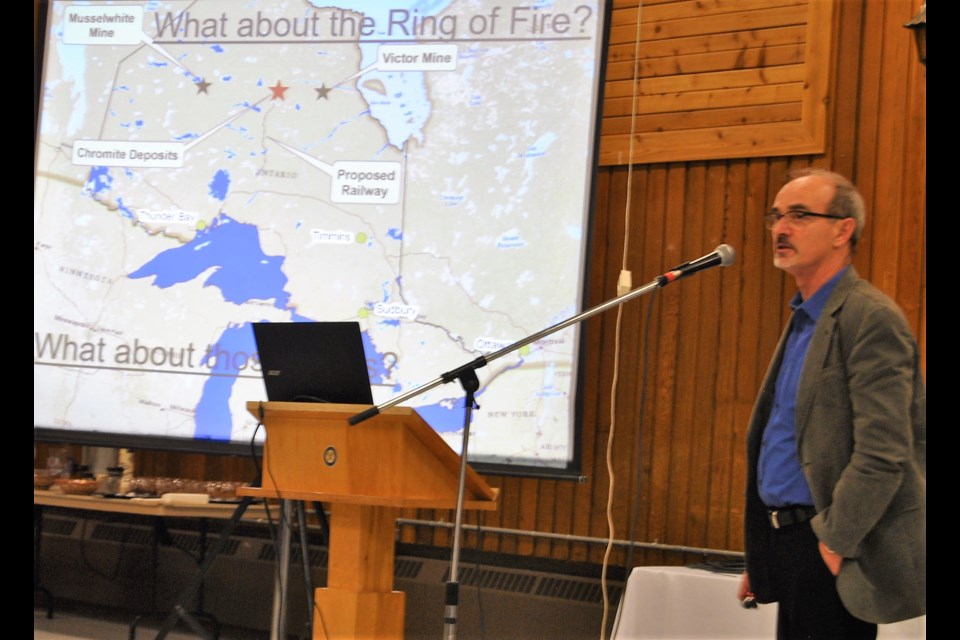In KWG Resources’ Moe Lavigne’s mind, the golden ring of economic prosperity is in the Ring of Fire, where his company, and others like Noront, have been trying for almost a decade to bring the area into mining production.
What’s missing is the fire, or the political will to provide the necessary transportation and electricity infrastructure to get the job done.
“You’ve heard that there is a potential for a $60 billion dollar in the Ring of Fire,” Lavigne, who is a Vice President at KWG. “The actual figure is actually closer to $600 Billion.”
Lavigne was addressing investors at the Canadian Mining Expo 2017’s Billions in the Ground investor seminar.
“While the figure is a mathematical exercise and not NI-43-101 compliant, this is the kind of vision politicians need to be promoting to make the Ring of Fire a reality,” Lavigne added.
NI-43-101 compliant is a code of practice required by law for mining companies to establishing the worth of the mineral potential at property.
Lavigne and others at the Canadian Mining Expo’s Billions in the Ground investors seminar did acknowledge that Premier Kathleen Wynne did signal her intention to proceed on the Ring of Fire even if all the parties’ do not reach agreement.
But the decade-long frustration was barely contained.
Lavigne said he was going to talk about the Ring of Fire.
“Talking about the Ring of Fire has become an industry unto itself,” Lavigne said to the sounds of laughter. “There has been a decade’s worth of the Ring of Fire talk.”
“The Ontario government has been pledging $1 billion in infrastructure investment in the Ring of Fire for a decade and not one cent has been spent,” Lavigne said.
When someone suggested that perhaps KWG shouldn’t wait for government to act and should consider side-stepping the slow-moving government, Lavigne responded that is what KWG is doing.
Lavigne’s presentation, navigated investors, through KWG’s game plan that is pegged on the building of a railway by Chinese engineers and the need of China for chromite.
China is the world’s largest stainless-steel manufacturer currently, it is suppliers in South Africa are unable to meet its growing demand for chromite.
Because Ontario’s natural gas prices are the lowest in the world, the conversion of chromite, using gas furnaces, will produce low cost ferro-chromium for China.
Demand is also increasing, as Canada, and other countries, replace old infrastructure such as bridges, highways, buildings built with highly corrosive iron rebars with rust-resistant stainless steel explained Lavigne.
Getting the Ring of Fire into production will take at least five years, according to Lavigne’s time line. That includes provincial and federal environmental assessments and various air, water and waste management permits from both levels of government.
Approvals will also be required for locating a ferro-chromium plant; with Timmins, Thunder Bay and Sudbury the most likely locations.
“Timmins would be the ideal location for the ferrochrome reduction facility,” said Timmins Mayor Steve Black. “Unlike, Thunder Bay, Timmins has plenty of brownfield locations that have been used for very similar uses.”
“We have a rail line that will be central to two new proposals locating in Timmins – the Calabrian SO2 plant and a Chinese operated basalt plant,” Mayor Black added.
“We are also closer to the Ring of Fire than either, Thunder Bay or Sudbury and that would reduce transportation costs,” Mayor Black explained.
The other key element in moving forward is obtaining the support of the First Nations to operate a mine and build infrastructures on their traditional lands.
“KWG is committed to working in a partnership with the First Nations in the Ring of Fire and the infrastructure that is built should help meet their needs as well as ours,” Lavigne stated.
Agreements in principals for a development partnership between KWG and Webequie and Marten Falls First Nations have been announced.
“A little more than a year ago, we welcomed the Webequie and Marten Falls First Nations joining forces to act together in concluding a Negotiation Protocol Respecting Early Exploration in the Ring of Fire,” said KWG President Frank Smeenk in a news release.
“The mining and transportation capital assets will be built on the traditional territories of the Webequie and Marten Falls First Nations,” Smeenk acknowledged.
Despite relying on railway for long haul of its chromite, roads will be needed to truck it from the mine face to the rail terminal.
“Let the terrain dictate the route of those roads,” said Lavigne. “Roads build on moraines and eskers will be cheaper than roots through bogs and muskegs.”
The hurdles to completed KWG’s Big Daddy Chromium Deposit
- Completing railroad feasibility study and submit fore EA
- Establish offtake agreements for sale of ferrochrome with China and other nations
- Secure Chinese financing to build railroad
- Commercialize gas reduction of chromite to ferrochrome
- Finance the development of the Black Horse chromite deposit
- Organize the ownership and the management of the mineral processing facilities, railroad and other infrastructure



